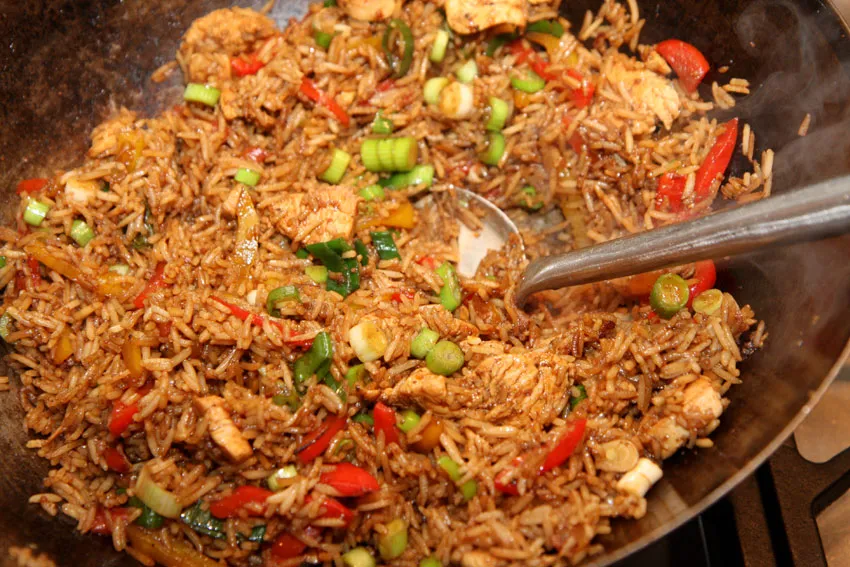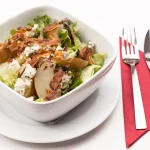The Best Fluffy Pancakes recipe you will fall in love with. Full of tips and tricks to help you make the best pancakes.
There’s a reason Chinese fried rice is a go-to favorite around the world—it’s quick, flavorful, and endlessly customizable. Whether you’re using up leftover rice or craving something savory and satisfying, fried rice is the kind of dish that delivers on taste without taking hours in the kitchen. But while it might seem simple, getting that perfect texture and restaurant-style flavor takes a few key techniques.
In this post, we’ll show you how to make Chinese fried rice that’s crispy, aromatic, and better than takeout. From choosing the right ingredients to mastering wok skills, you’ll learn everything you need to cook this classic dish like a pro—every single time.
Why Chinese Fried Rice Is the Ultimate Quick Meal
Chinese fried rice is more than just a tasty dish—it’s a weeknight hero. It checks all the boxes for what we want in a quick meal: simple ingredients, fast prep, and satisfying results. Here’s why it deserves a regular spot in your dinner rotation:

🍚 Great Way to Use Leftover or Day-Old Rice
One of the best parts about fried rice is its love for leftovers. In fact, day-old rice is preferred because it’s firmer and drier, making it ideal for stir-frying. Instead of throwing out last night’s rice, you can turn it into a delicious new meal with very little effort.
🥢 Customizable With Ingredients You Already Have
Got a handful of peas, half a bell pepper, or a leftover chicken breast? Toss them into the wok! Fried rice is incredibly flexible—you can make it vegetarian, add protein, or spice it up with sauces you already have in your pantry. It’s the ultimate fridge-cleanout dish.
⏱️ Ready in Under 20 Minutes
Once your ingredients are prepped, the cooking process takes just 10–15 minutes. That’s faster than ordering takeout! With a hot pan and a few simple steps, you’ll have a hot, satisfying meal on the table in no time.
🥡 Tastes Better (and Healthier) Than Takeout
When you make it yourself, you control the oil, salt, and sauces. This means your fried rice can be healthier without sacrificing flavor. Plus, no mystery ingredients—just fresh, whole foods you recognize and enjoy.
Ingredients You’ll Need for Authentic Flavor
To make Chinese fried rice that rivals your favorite restaurant, it all starts with the right ingredients. While the dish itself is flexible, there are a few key components that bring that unmistakable savory flavor, golden color, and satisfying texture. Here’s what you’ll need:
🍚 Day-Old Jasmine Rice
The foundation of perfect fried rice is cold, day-old rice. Freshly cooked rice tends to be too soft and sticky, resulting in clumps. Day-old jasmine rice is ideal—it’s slightly dry, aromatic, and separates beautifully in the wok for that fluffy, fried texture. If you’re in a pinch, spread freshly cooked rice on a tray and refrigerate it for at least an hour.
🧄 Aromatics: Garlic, Ginger, and Green Onions
These three ingredients form the base flavor of most Chinese stir-fries.
- Garlic adds a sharp, savory depth.
- Ginger gives a warm, slightly spicy kick.
- Green onions (scallions) offer freshness and a mild onion flavor.
Sautéing them first in hot oil infuses the entire dish with bold aroma.
🥚 Eggs for Soft Texture and Color
A classic element in Chinese fried rice is scrambled eggs. They bring richness, color, and protein. Lightly beat a couple of eggs and scramble them before mixing them back in with the rice at the end.
🥕 Mixed Vegetables
Frozen or fresh peas, carrots, and corn are traditional and add both color and sweetness. Feel free to use what you have on hand—diced bell peppers, mushrooms, or bean sprouts all work beautifully.
🍗 Optional Proteins
To make your fried rice more filling, add pre-cooked proteins such as:
- Chicken (grilled or shredded)
- Shrimp (lightly sautéed)
- Pork (leftover BBQ pork is a favorite in Chinese takeout)
- Tofu (for a vegetarian twist)
🥢 Sauces for Signature Flavor
The combination of sauces is what sets fried rice apart. Use:
- Light soy sauce for salt and umami
- Dark soy sauce for a rich color and deeper flavor
- Oyster sauce (optional) for a hint of sweetness and complexity
- A dash of sesame oil at the end for that nutty aroma
✨ Optional Flavor Boosters
- White pepper for gentle heat
- MSG (if you want that true takeout flavor—totally optional)
- Chili oil or sauce for a spicy kick
Step-by-Step Instructions for Perfect Fried Rice Every Time
Making restaurant-quality Chinese fried rice at home might seem tricky, but once you follow these simple steps, you’ll master it in no time. The secret lies in preparation, high heat, and the order in which you add ingredients to the pan.
🔪 Step 1: Prep All Your Ingredients Before Cooking
Fried rice cooks fast, so you’ll want everything chopped, measured, and ready to go before the heat hits the pan. Dice your vegetables, scramble your eggs in a bowl, and portion out your sauces. If you’re using leftover meat or tofu, have it sliced or cubed and ready to toss in.
Pro tip: Use small bowls for each ingredient like a stir-fry station—it keeps everything organized and stress-free.
🍳 Step 2: Scramble the Eggs and Set Aside
Heat a tablespoon of oil in your wok or large skillet over medium-high heat. Pour in the beaten eggs and scramble them quickly until just cooked. Then, remove them from the pan and set aside. You’ll mix them back in later to keep them fluffy and tender.
🧄 Step 3: Stir-Fry Aromatics and Vegetables
Add another tablespoon of oil to the hot pan. Toss in your garlic, ginger, and green onions, and stir-fry for 20–30 seconds until fragrant. Then, add the vegetables (like peas, carrots, and corn) and cook until they’re heated through and slightly golden.
Optional: If adding protein (like shrimp or chicken), stir-fry it now until fully cooked, then remove and set aside with the eggs.
🍚 Step 4: Add the Cold Rice and Break It Up
Add your day-old rice to the pan. Use a spatula to break up any clumps and spread the rice evenly across the surface of the pan. Let it sit undisturbed for 30–60 seconds at a time before stirring—this helps develop that crispy, slightly toasted texture.
🥢 Step 5: Season With Sauces and Reintroduce the Eggs
Pour in the light and dark soy sauce, and a touch of oyster sauce if using. Stir-fry until the rice is evenly coated. Return the scrambled eggs (and any cooked protein) to the pan and toss everything together until well combined and piping hot.
Finish with a drizzle of sesame oil for aroma, and add white pepper or chili oil if desired.
Pro Tips for Getting That Takeout Taste at Home
If you’ve ever wondered why restaurant-style Chinese fried rice tastes richer, smokier, and more balanced than homemade versions, you’re not alone. The good news? With a few insider tips, you can recreate that irresistible takeout-style flavor right in your own kitchen. Here’s how:
🔥 Use a Hot Wok (or the Hottest Pan You Have)
Professional kitchens use high-powered woks that reach searing temperatures. While you may not have that at home, you can preheat your wok or large nonstick skillet until it’s very hot before adding oil. This ensures your ingredients sear instead of steam and gives your rice that slightly crisp, golden texture known as “wok hei”—a smoky, charred flavor that’s the hallmark of great fried rice.
🚫 Don’t Overcrowd the Pan
Too much food in the pan lowers the temperature, leading to soggy rice. If you’re cooking a large batch, work in batches to maintain heat. Give the ingredients room to move and fry properly—you want that light crisp on the edges, not a mushy pile of rice.
❄️ Always Use Cold, Day-Old Rice
Freshly cooked rice is soft and sticky—not ideal for frying. Cold rice has dried out slightly, making it easier to separate into individual grains. If you’re in a rush, spread fresh rice on a tray and chill it uncovered in the fridge for an hour or two before using.
🥄 Balance Your Sauces
Takeout fried rice has a distinct umami depth because it combines light soy sauce, dark soy sauce, and sometimes oyster sauce. Don’t go overboard—too much sauce will make the rice mushy and overly salty. Add sauces gradually and taste as you go. A splash of sesame oil at the end ties everything together with that signature nutty aroma.
🍳 Cook Eggs and Proteins Separately
This small step makes a big difference. Scrambling eggs and cooking proteins separately keeps them tender and flavorful, avoiding the rubbery texture that can happen when they’re overcooked in the rice.
🌶️ Optional Add-Ons for Extra Flavor
Want to take it up a notch? Add a small pinch of MSG for that authentic takeout umami kick (totally optional), a dash of white pepper for subtle heat, or a swirl of chili crisp or hot sauce for spice lovers.
Delicious Variations and Serving Ideas
One of the greatest things about Chinese fried rice is how adaptable it is. You can change up the flavors, mix in different ingredients, and serve it in creative ways depending on your mood or what you have on hand. Here are some tasty variations and fun serving suggestions to inspire your next batch:
🍗 Protein-Packed Variations
Add heartiness and flavor with your favorite proteins. Here are a few classic and creative choices:
- Chicken Fried Rice – Use cooked, shredded or diced chicken breast or thigh. Great for leftover rotisserie chicken!
- Shrimp Fried Rice – Lightly sauté shrimp with a dash of garlic and soy sauce before tossing into the rice.
- Beef Fried Rice – Thinly sliced, quick-seared beef (like flank or sirloin) adds a savory, satisfying touch.
- Tofu Fried Rice – For a vegetarian option, use crispy pan-fried tofu cubes to absorb all the flavor.
Tip: Always pre-cook your proteins and add them at the end to avoid overcooking.
🥦 Vegetarian and Vegan Options
Skip the meat and enjoy a colorful, veggie-packed fried rice:
- Add bell peppers, mushrooms, snow peas, bean sprouts, or bok choy
- Use toasted cashews or edamame for added protein and crunch
- Replace eggs with a sprinkle of toasted sesame seeds or crispy onions for texture
Drizzle with a vegan-friendly soy sauce or tamari for extra depth.
🍍 Creative Flavor Twists to Try
Want to step outside the traditional version? These fusion-style variations are crowd-pleasers:
- Pineapple Fried Rice – Add diced fresh or canned pineapple for a sweet-and-savory Thai-inspired dish
- Kimchi Fried Rice – Stir in chopped kimchi for a bold, tangy, spicy Korean twist
- Basil Fried Rice – Add Thai basil and chilies for a herby, fragrant variation
- Curry Fried Rice – A spoonful of curry powder or paste can completely transform the flavor profile
🍱 Serving Ideas for a Complete Meal
Fried rice is great on its own, but it’s even better as part of a full spread. Pair it with:
- Spring rolls or egg rolls
- Steamed or pan-fried dumplings
- Hot and sour soup or wonton soup
- Stir-fried vegetables or a cucumber salad for a light side dish
- Serve your fried rice in a pineapple bowl or lettuce cups for a fun presentation
Hosting a dinner party? Offer multiple fried rice versions (chicken, veggie, spicy) and let guests mix and match with toppings and sauces.






What’s up, just wanted to mention, I enjoyed this post.
It was practical. Keep on posting!